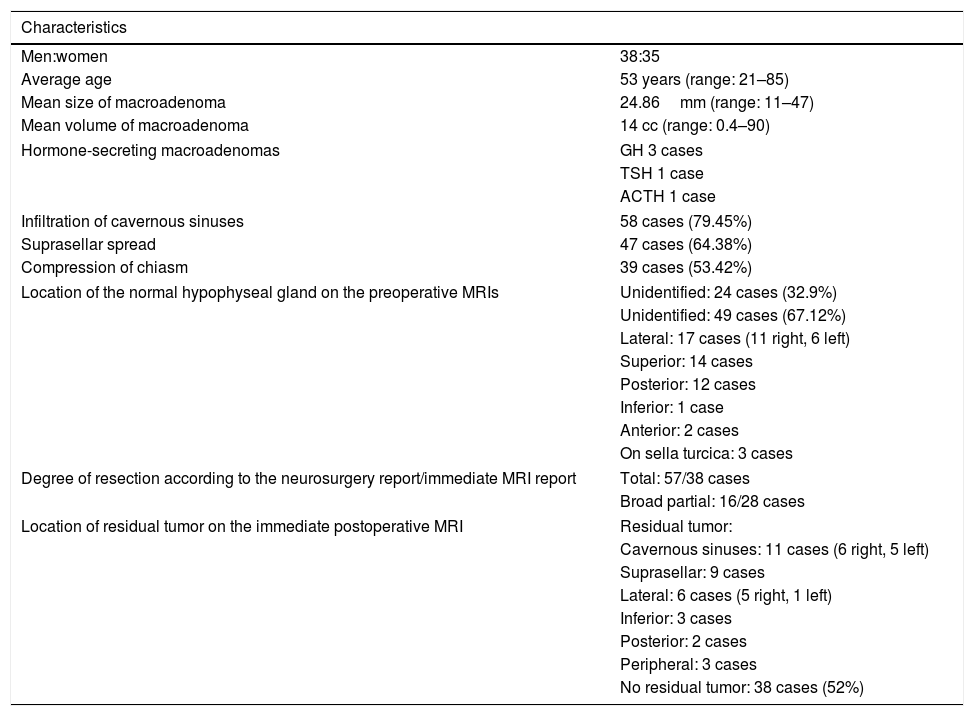To evaluate if it is possible to determine the extent of pituitary macroadenomas resection in the immediate postoperative pituitary magnetic resonance imaging (MRI).
Material and methodsMRI of patient with pituitary macroadenomas from January 2010 until October 2014 were reviewed. Those patients who had diagnostic MRI, immediate post-surgical MRI and at least one MRI control were included. We evaluate if the findings between the immediate postsurgical MRI and the subsequent MRI were concordant. Cases which did not have evolutionary controls and those who were reoperation for recurrence were excluded. The degree of tumor resection was divided into groups: total resection, partial resection and doubtful. All MRI studies were performed on a 1.5T machine following the same protocol sequences for all cases. One morphological part, a dynamic contrast IV and late contrast part.
ResultsOf the 73 cases included, immediate postoperative pituitary MRI was interpreted as total resection in 38 cases and tumoral rest in 28 cases, uncertainty among rest or inflammatory changes in 7 cases. Follow-up MRI identified 41 cases total resection and tumoral rest in 32. Sensitivity and specificity of 0.78 and 0.82 and positive and negative predictive value (PPV and NPV) 0.89 and 0.89 respectively were calculated.
ConclusionImmediate post-surgery pituitary MRI is useful for assessing the degree of tumor resection and is a good predictor of the final degree of real resection compared with the following MRI studies. It allows us to decide the most appropriate treatment at an early stage.
Comprobar si es posible determinar el grado de resección de macroadenomas hipofisarios en la resonancia magnética (RM) hipofisaria posquirúrgica inmediata.
Material y métodosSe revisaron las RM hipofisarias de pacientes intervenidos desde enero de 2010 hasta octubre de 2014. Se incluyeron aquellos que tenían RM diagnóstica, RM posquirúrgica inmediata y al menos un control posterior. Se comprobó si los hallazgos entre la RM posquirúrgica inmediata y las RM posteriores eran concordantes. Se excluyeron los casos sin controles evolutivos y las reintervenciones por recidivas. El grado de resección tumoral lo dividimos en grupos: resección total, resección parcial y dudoso. Los estudios se realizaron en una máquina de 1.5T siguiendo el mismo protocolo de secuencias: una parte morfológica, otra dinámica con contraste intravenoso y otra con contraste tardío.
ResultadosDe 73 casos incluidos, la RM posquirúrgica inmediata se interpretó como resección total en 38 casos y resto tumoral en 28 casos, habiendo dudas en 7 casos. En los controles evolutivos se determinó resección total en 41 casos y resto tumoral en 32. Se obtuvo una sensibilidad para detección de restos tumorales de 0,71, una especificidad de 0,82, un valor predictivo positivo de 0,89 y un valor predictivo negativo de 0,85 en la RM posquirúrgica inmediata respecto a los controles evolutivos.
ConclusiónLa RM posquirúrgica inmediata de macroadenomas hipofisarios es útil para valorar el grado de resección tumoral y es un buen predictor del grado de resección real definitivo al comparar con las RM posteriores, permitiendo plantear el tratamiento adecuado de forma precoz.












